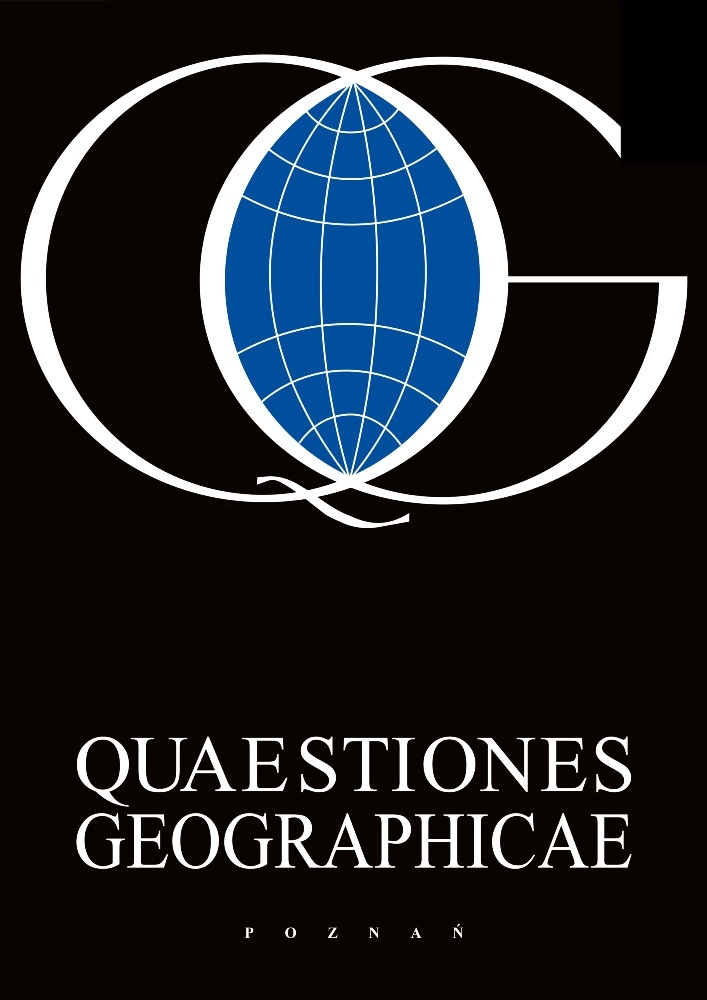Abstract
The paper indicates the relations between geodiversity and geotourism in the Tatra National Park. Geodiversity of the Tatra Mountains is visualized by its geodiversity map, whereas geotouristic attractions are measured by touristic attractions along touristic trails on geodiversity map. Areas of the highest geodiversity cover merely 8.2% of the Tatar National Park area. These are mainly areas close to the Tatra Mountains' main ridge. It is so due to geology, landform energy, slopes, landform fragmentation and geoecological belts. Most of the analyzed thematic layers categorizes ridges as more geodiversed than valley areas. The trails situated in the valley bottoms usually cross by areas of low geodiversity, however, from geotouristic point of view, it should be noted that slopes and ridges circumvolving the valley can be marked by high geodiversity. The mountain slopes and ridges are within tourist's sight, what increases trail's geotouristic attractiveness. Amongst many geotouristically interesting parts of the Tatra Mountains Dolina Pięciu Stawów valley appears to be the most appealing with its high quantity and high variety of post-glacial forms on valley's bottom as well as on its slopes.
References
Asrat A., Demissie M. & Mogessie A., 2008. Geotourism in Ethiopia. Shama Books, Addis Ababa.
Castaldini D., 2012. Maps and multimedia tool for the popularization and promotion of protected areas of the Apennines of Modena (northern Italy). In: C. Giusti (ed.), Géomorphosites 2009: imagerie, inventaire, mise en valeur et vulgarisation du patrimoine géomorphologique. Paris: 60-65.
Cayla N., Hoblea F. & Gasquet D., 2012. Place de la géomorphologie dans l'offre géotouristique de l'arc alpin: du réel au virtuel. In: C. Giusti (ed.), Géomorphosites 2009: imagerie, inventaire, mise en valeur et vulgarisation du patrimoine géomorphologique. Paris: 65-71.
Chybiorz R. & Tyc A., 2011. Georóżnorodność rzeźby w województwie śląskim. In: M. Mazurek, M. Ewertowski (red.), 2011. Georóżnorodność rzeźby Polski, Poznań: 30.
GeoPortal Tatry, 2012. WMS. Online: http://www.geoportaltatry.pl/
Gray M., 2004. Geodiversity: Valuing and Conserving Abiotic Nature. Wiley, Chichester.
Gray M., 2008. Geodiversity: the origin and evolution of a paradigm. In: C.V. Burek & C.D. Prosser (eds), The History of Geoconservation. Geological Society, London, Special Publication, 300: 37-70. DOI: https://www.doi.org/10.1144/SP300.4.
Hose T.A., 2008. Towards a history of geotourism: definitions, antecedents and the future. In: C.V. Burek & C.D. Prosser (eds), The History of Geoconservation. Geological Society, London, Special Publication, 300: 31-36. DOI: https://www.doi.org/10.1144/SP300.5.
Jačková K., Romportl D., 2008. The Relationship between Geodiversity and Habitat Richness in Šumava National Park and Křivoklátsko Pla (Czech Republic): A Quantitative Analysis Approach. Journal of Landscape Ecology, 1(1).
Joyce E.B., 2010. Australia's Geoheritage: History of Study, A New Inventory of Geosites and Applications to Geotourism and Geoparks. Geoheritage, 2(1-2): 39-56.
Kostrzewski A., 1998. Georóżnorodność rzeźby jako przedmiot badań geomorfologii. In: K. Pękala (ed.), Główne kierunki badań geomorfologicznych w Polsce stan aktualny i perspektywy, IV Zjazd Geomorfologów Polskich, UMCS, Lublin, p. 11-16.
Kostrzewski A., 2011. The role of relief geodiversty in geomorphology. Geographia Polonica, 84(Sp. Iss. Pt 2): 69-74.
Kot R., 2006. Georóżnorodność - problem jej oceny i zastosowania w ochronie i kształtowaniu środowiska na przykładzie fordońskiego odcinka dolnej Wisły i jej otoczenia. Studia Societatis Scientiarum Torunensis, Sectio C (Geographia et Geologia), 11(2): 1-190.
Kot R., 2009, Próba ujednolicenia rangi jednostek rzeźby terenu dla delimitacji geokompleksów wybranych krajobrazów nizinnych. Problemy ekologii krajobrazu, 23: 167-179.
Kot R., Leśniak K., 2006. Ocena georóżnorodności za pomocą miar krajobrazowych - podstawowe trudności metodyczne. Przegląd Geograficzny, 78(1): 25-45.
Kot R., Szmidt K., 2010. Ocena georóżnorodności rzeźby terenu fragmentu Basenu Świeckiego w skalach 1:10 000 oraz 1:25 000. Problemy Ekologii Krajobrazu, 27: 189-196.
Malczewski J., 2000. On the Use of Weighted Linear Combination Method in GIS: Common and Best Practice Approaches. Transactions in GIS, 4(1): 5-22.
Mizgajski A., 2001. Odniesienie georóżnorodności do wybranych pojęć w naukach o środowisku. In: Funkcjonowanie geoekosystemów w zróżnicowanych warunkach morfoklimatycznych. Monitoring, ochrona, edukacja, A.Karczewski & Z. Zwoliński, Bogucki Wydawnictwo Naukowe, Poznań: 369-375.
Mrowczyk P., Madeja G., Doktor M., 2010. Zagospodarowanie obiektów geoturystycznych na terenie parku narodowego na przykładzie Doliny Pięciu Stawów Polskich. Problemy Ekologii Krajobrazu, 27: 473-476.
Reynard E., Erhartic B., Kozina K., Martin S., Regolini G., Rovere A., Theler D. & Vacchi M., 2012. Mapping the geomorphological heritage for geotourist purposes: the case of Derborence Lake area (Switzerland). In: C. Giusti (ed.), Géomorphosites 2009: imagerie, inventaire, mise en valeur et vulgarisation du patrimoine géomorphologique. Paris: 281-282.
Rodrigues M.-L. & Fonseca A., 2012. From geomorphological Survey and mapping to Geoheritage and geotouristic maps. Application in a Karst area - The Fórnia (EML, Portugal). In: C. Giusti (ed.), Géomorphosites 2009: imagerie, inventaire, mise en valeur et vulgarisation du patrimoine géomorphologique. Paris: 282-283.
Sapp M., Gaido M.F. & Miró R.C., 2009. A Geodiversity Map: Geological-Tourist Map Of Calamuchita's Valley, Cordoba, Argentina. Proc. 24th Int. Cartogr. Conf., Santiago de Chile. p. 5.
Serrano E., Ruiz-Flaño P., 2007. Geodiversity: a theoretical and applied concept. Geographica Helvetica, 62: 140-147.
Serrano E., Ruiz-Flaño P., Arroyo P., 2009. Geodiversity assessment in a rural landscape: Tiermes-Caracena area (Soria, Spain). Mem. Descr. Carta Geol. d'It., 87: 173-180.
TPN [Tatra National Park], 2012. Tatrzański Park Narodowy. Online: http://tpn.pl/
Zwoliński Zb., 2004a. Geodiversity. In: A.S. Goudie (ed.), Encyclopedia of Geomorphology, Vol. 1, Routledge, 417-418.
Zwoliński Zb., 2004b. Koncepcja mapy geoturystycznej (Conception of geotouristic map). In: L. Kozacki & B. Medyńska-Gulij, (eds.), Kartografia tematyczna w kształtowaniu środowiska geograficznego. Bogucki Wyd. Nauk., Poznań: 293-301.
Zwoliński Zb., 2007. Methodology for determining landform geodiversity in Poland, IAG/AIG Regional Conference on Geomorphology, Kota Kinabalu, Malaysia, 25-29 June 2007, 30.
Zwoliński, Zb., 2008. Designing a map of the geodiversity of landforms in Poland. IAG and AIGEO International Meeting "Environmental Analysis and Geomorphological Mapping for a Sustainable Development", Addis Ababa, Ethiopia, February 26, 2008. Abstract Book, p. 18-22.
Zwoliński Zb., 2009. The routine of landform geodiversity map design for the Polish Carpathian Mts. In: E. Rojan & A.Łajczak (Eds.), Geoecology of the Euroasiatic Alpids. Landform Analysis, 11: 79-87.
Zwoliński Zb., 2010. Aspekty turystyczne georóżnorodności rzeźby Karpat. Prace Komisji Krajobrazu Kulturowego PTG, 14: 316-327.
License
This content is open access.
